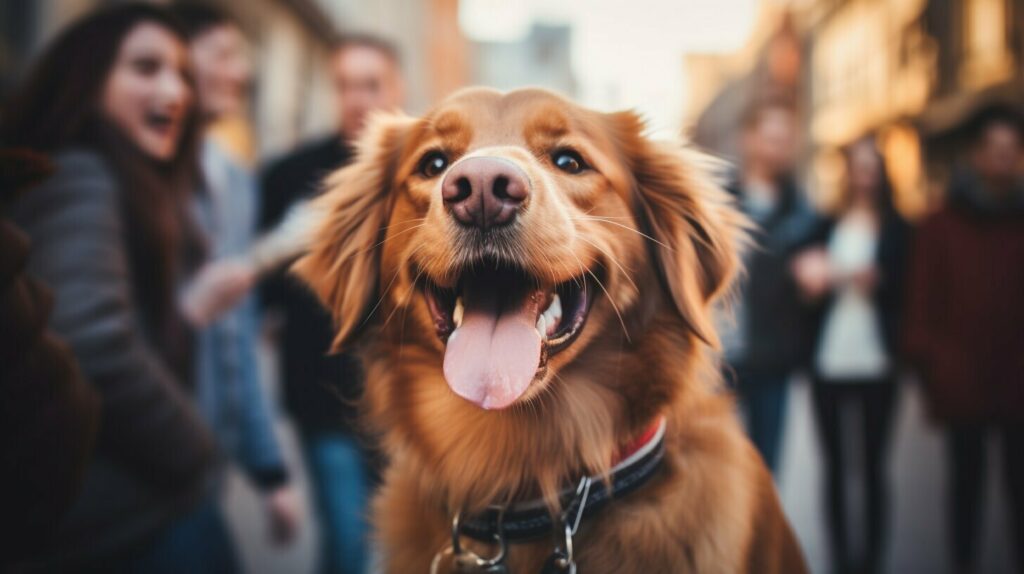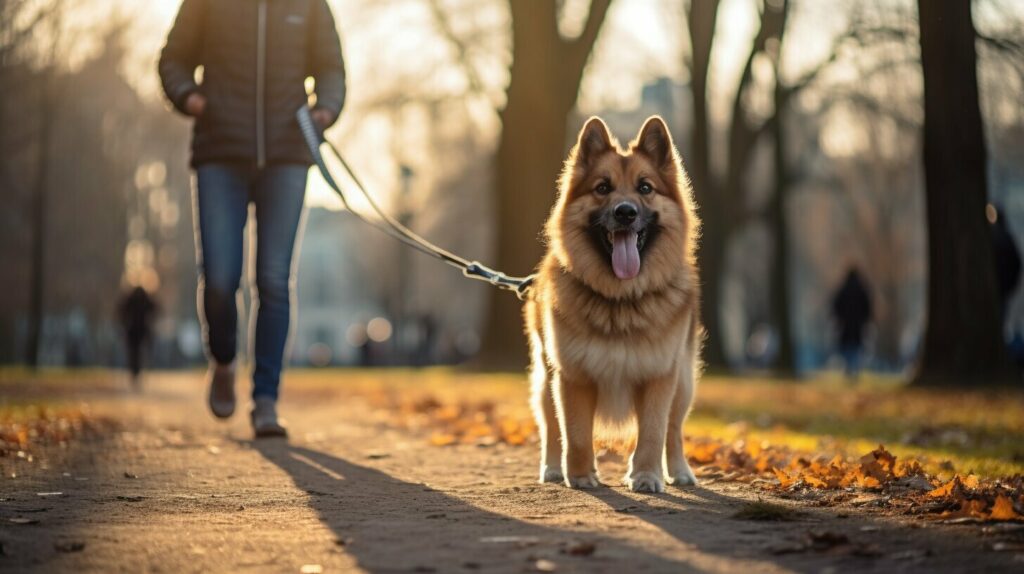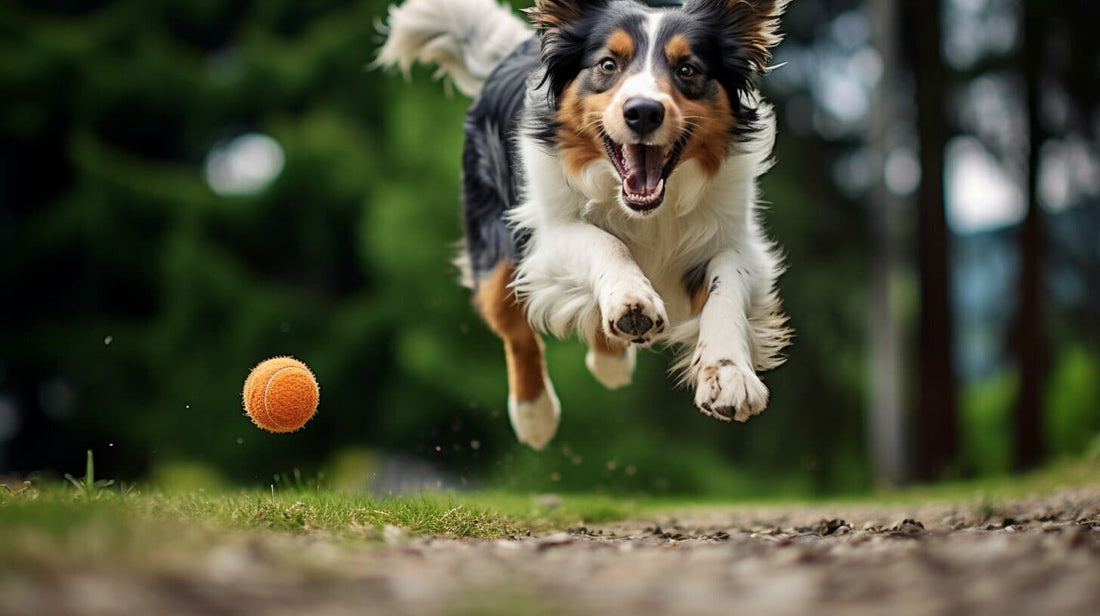Welcome to our comprehensive guide on dog training techniques. As a dog owner, you want your furry friend to be well-behaved and happy. Using effective training techniques can help you achieve that goal. In this article, we will cover a range of training methods, from basic commands to advanced techniques, to help you and your pooch establish a strong bond.
Key Takeaways:
- Dog training techniques are essential for a happy and well-behaved pet.
- We will cover a range of training methods, including positive reinforcement and advanced techniques.
- Consistency and patience are crucial for successful dog training.
- Applying training techniques to everyday routines helps reinforce positive behaviors.
Understanding Positive Dog Training Techniques
Positive reinforcement is one of the most effective and humane dog training techniques. This method involves rewarding good behavior with treats, praise, and toys, instead of punishing bad behavior. By using positive reinforcement, you can build a strong bond with your dog and create a fun and engaging training environment.
The key to successful positive dog training is to find the right motivator for your dog. This could be a favorite treat, a special toy, or a lot of praise and affection. Once you have identified what your dog finds rewarding, you can use it to encourage good behavior and teach new commands.
It is important to remember that positive reinforcement should be immediate and consistent. If your dog does something good, you should reward them right away. This will help them understand what they did correctly and encourage them to repeat it in the future. Similarly, if your dog does something wrong, redirect their attention to a positive behavior and reward them for doing it correctly.
Positive dog training techniques can be used to teach a wide range of commands, from basic obedience to advanced tricks. By focusing on positive reinforcement, you can help your dog develop good habits and build a happy and healthy relationship with them.
Examples of Positive Reinforcement
| Reward | Behavior |
|---|---|
| Treat | Sit, stay, come |
| Praise | Good boy/girl, well done |
| Toy | Fetch, drop it, leave it |
Remember, positive reinforcement is about rewarding good behavior, not bribing your dog with treats. Use treats and rewards sparingly, and with consistency, to build a strong, positive bond with your furry friend!
Modern and Advanced Dog Training Techniques
In recent years, modern and advanced dog training techniques have gained popularity due to their effectiveness in achieving desired outcomes. These techniques utilize unique methods that enhance communication and create a positive association with learning for the dog.
Clicker training is a popular modern technique that involves using a small handheld device that emits a distinct clicking sound to mark desired behaviors. It is a powerful communication tool that allows the trainer to provide instant feedback and is especially effective in shaping new behaviors.
Shaping is another advanced technique that involves breaking down complex behaviors into smaller, manageable steps. By gradually increasing the level of difficulty, the dog learns to complete the complex behavior through a series of smaller, simpler tasks.
Targeting is a technique that involves teaching the dog to touch a specific target, such as a stick or a ball, with their nose or paw. This technique is useful in teaching dogs how to perform tricks and can be used to redirect unwanted behavior.
These modern and advanced dog training techniques are highly effective and can help create a strong bond between dog and trainer. However, it's important to note that these techniques require proper training and guidance to ensure their effectiveness and to avoid causing any undue stress or harm to the dog. Therefore, it's always recommended to consult with a professional dog trainer before attempting these techniques on your own.
Basic Dog Training Techniques for Beginners
Training a new dog can be overwhelming for beginners, but it's essential for creating a happy and well-behaved pooch. These basic dog training techniques will help you get started on the right path:
Sit Command
The "sit" command is one of the most important commands to teach your dog. It's easy to teach and can help prevent unwanted behavior. Here's how:
| Steps: | 1. Hold a treat close to your dog's nose. |
|---|---|
| 2. Slowly move the treat up, causing your dog's head to follow it, and eventually causing their backside to lower. | |
| 3. Once your dog is in a sitting position, say "sit" and give them the treat. |
Stay Command
The "stay" command will help keep your dog under control in various situations, including crossing the road, greeting guests, and during vet checkups. Here's how to teach it:
| Steps: | 1. Ask your dog to sit down. |
|---|---|
| 2. Open your palm and say "stay". | |
| 3. Take a few steps backward and reward your dog for staying. | |
| 4. Gradually increase the number of steps and time that you ask your dog to stay. |
Come Command
The "come" command is essential for your dog's safety, ensuring they return to you when called. Here's how to teach it:
| Steps: | 1. Get down to your dog's level and say their name. |
|---|---|
| 2. Say "come" in a friendly voice, and reward your dog when they come to you. | |
| 3. Gradually increase the distance between you and your dog, and use the command in real-life situations, such as on a walk or in the park. |
Remember to use positive reinforcement, such as treats and praise, when teaching new commands. Consistency is key, and don't forget to keep training sessions short, fun, and rewarding for your furry friend.
Effective Leash Training Techniques
Leash training is an essential part of dog training that ensures the safety of both the dog and the owner. A well-trained dog can enjoy walks and outdoor activities while being under control and not putting themselves or others in danger. Here are some effective leash training techniques:
Loose Leash Walking
The goal of loose leash walking is to teach your dog to walk calmly by your side without pulling on the leash. Start by using a regular leash and stand still when your dog pulls. When the leash is loose, walk forward and reward your dog with praise and treats when they walk by your side. Gradually increase the distance and duration of walking together without pulling. Consistency and patience are key.
Desensitization
If your dog is afraid of the leash or becomes anxious or aggressive when seeing it, desensitization can help. Start by leaving the leash in an accessible area where your dog can smell it and get used to it. Gradually associate the leash with positive experiences, like going for a walk or receiving treats while wearing it. This will help your dog overcome their fear or anxiety and associate the leash with positive experiences.
Remember that leash training takes time and patience. Always use positive reinforcement techniques and never punish or physically harm your dog. With consistency and patience, you can help your dog become a well-behaved and happy companion!
Recommended Dog Training Techniques for Behavioral Issues
If your dog is exhibiting problematic behaviors such as aggression, separation anxiety, or excessive barking, it's important to address these issues promptly. Here are some recommended dog training techniques to help with common behavioral issues:
Aggression
Aggression is a serious issue that needs to be dealt with carefully and by a professional if necessary. However, there are some techniques that can be used to help manage this behavior:
| Recommended Techniques | How It Helps |
|---|---|
| Positive Reinforcement | Teaching your dog to associate good behavior with rewards can help to reduce aggressive tendencies. |
| Desensitization and Counter-Conditioning | This technique involves gradually exposing your dog to the trigger that causes their aggression, while keeping them calm and rewarding them for peaceful behavior. |
Separation Anxiety
Dogs who experience separation anxiety may exhibit destructive behavior, excessive barking, and other problematic behaviors when left alone. Here are some techniques to help manage this behavior:
| Recommended Techniques | How It Helps |
|---|---|
| Gradual Departures and Returns | By gradually increasing the amount of time you spend away from your dog and rewarding them for calm behavior upon your return, you can help to ease their anxiety. |
| Positive Reinforcement | Positive reinforcement techniques can help to reduce anxiety by teaching your dog to associate your departures and returns with positive experiences. |
Excessive Barking
Excessive barking can be a nuisance for both you and your neighbors. Here are some techniques to help manage this behavior:
| Recommended Techniques | How It Helps |
|---|---|
| Positive Reinforcement | Teaching your dog to associate quiet behavior with rewards can help to reduce excessive barking. |
| Desensitization | Gradually exposing your dog to the triggers that cause excessive barking can help to desensitize them to those triggers and reduce barking. |
Remember, if your dog's behavioral issues are severe or persistent, it's important to seek professional help. With patience and consistency, however, most problematic behaviors can be managed or even eliminated.

Training Techniques for Specific Dog Breeds
When it comes to training your furry friend, it's important to consider their breed and unique characteristics. Different breeds have different instincts and tendencies, which can impact their behavior and training needs. Here are some breed-specific training techniques to keep in mind:
| Breed | Training Techniques |
|---|---|
| Labrador Retriever | Labradors are highly food-motivated, making positive reinforcement training with treats an effective technique. They also love to retrieve, so incorporating games of fetch into training can be helpful. |
| German Shepherd | German Shepherds are known for their intelligence and loyalty, but can also be protective and prone to aggression. Training should focus on socialization and obedience, with early socialization and positive reinforcement being key. |
| Poodle | Poodles are intelligent and eager to please, making them highly trainable. Positive reinforcement techniques such as treats and praise work well, as do engaging activities like agility training. |
| Bulldog | Bulldogs can be stubborn and headstrong, so training should focus on consistency and positive reinforcement. Short training sessions with positive rewards work well, and early socialization can help prevent aggression towards other dogs. |
Remember, every dog is unique and may require different types of training techniques. It's important to understand and work with your dog's natural instincts and tendencies to ensure successful training outcomes.

Tips for Successful Dog Training
Training your dog can be a rewarding experience for both you and your furry friend. However, it can also be challenging at times. Here are some tips to help you achieve success:
- Be patient and consistent: Dogs thrive on routine and consistency, so it’s important to establish a regular training schedule and stick to it. Remember that learning takes time, so be patient and avoid getting frustrated.
- Use positive reinforcement: Praise, treats, and other rewards are powerful motivators for dogs. Use them to encourage good behavior and avoid punishment, which can be counterproductive and damage the bond between you and your dog.
- Set realistic goals: Don’t expect your dog to master a new command overnight. Break down more complex skills into smaller, achievable steps, and celebrate each small success along the way.
- Create a positive training environment: Remove distractions, such as toys or other pets, and choose a quiet, well-lit space for training sessions. Make sure your dog is comfortable and relaxed, and always end training sessions on a positive note.
- Stay attuned to your dog’s needs: Pay attention to your dog’s body language and behavior during training sessions. If your dog seems stressed or disinterested, take a break and try again later.
Remember, training is more than just teaching your dog commands – it’s about building a strong, trusting relationship based on mutual respect and understanding. By using positive, effective training techniques, you can help your dog learn and grow while strengthening your bond.

Incorporating Training into Everyday Life
Training your dog doesn't have to be limited to formal sessions. In fact, incorporating training into your everyday routine can be a fun and effective way to reinforce good behavior and strengthen your bond with your furry friend. Here are some tips for integrating dog training into your daily life:
During Walks
Walks are a great opportunity for training and exercise. Use the time to work on commands such as "heel," "stay," and "come." Start with short distances and gradually increase the difficulty level. Remember to reward your dog with treats and praise for good behavior.

During Mealtime
Mealtime can also be used for training. Use your dog's kibble as treats and ask them to perform a command before giving them their food. This reinforces good behavior and helps prevent food aggression.
During Social Interactions
Socializing your dog is important for their development. Take advantage of opportunities to socialize your dog with other people and pets. Use these interactions to reinforce good behavior and work on commands such as "leave it" and "come."
By incorporating training into your daily routine, you can reinforce good behavior and strengthen your bond with your furry friend. Remember to keep the training sessions short and positive, and always end on a high note. With patience and consistency, your dog will be well-behaved and happy.
Conclusion
Training your furry companion can be a fun and rewarding experience that strengthens the bond between you and your dog. By using positive, effective training techniques, you can ensure that your dog is happy, well-behaved, and a pleasure to be around.
Remember to set realistic goals and be patient and consistent throughout the training process. Seek professional help if needed, especially when dealing with more complex or challenging behavioral issues.
It's also important to incorporate training into your dog's everyday routine and situations, such as during walks, mealtime, and social interactions. This will reinforce the behaviors you want to encourage and prevent unwanted behaviors from becoming habits.
Takeaway Tip:
If you're unsure of where to start with training your dog, begin with basic commands such as "sit," "stay," and "come." Use positive reinforcement techniques such as treats, praise, and rewards, and be sure to practice consistently.
With patience and dedication, you can create a happy and well-behaved dog that brings joy to your life for years to come.
FAQ
Q: What are dog training techniques?
A: Dog training techniques are methods and strategies used to teach dogs skills, obedience, and good behavior.
Q: Why are dog training techniques important?
A: Dog training techniques are important because they ensure that dogs are well-behaved, happy, and can live harmoniously with their owners and in society.
Q: What are positive dog training techniques?
A: Positive dog training techniques involve using rewards, treats, and praise to reinforce desired behaviors in dogs.
Q: What are modern and advanced dog training techniques?
A: Modern and advanced dog training techniques include methods such as clicker training, shaping, and targeting to enhance communication and improve training outcomes.
Q: What are basic dog training techniques for beginners?
A: Basic dog training techniques for beginners include teaching commands like sit, stay, and come, with an emphasis on consistency and positive reinforcement.
Q: How can I leash train my dog effectively?
A: Effective leash training techniques include loose leash walking and desensitization to help dogs overcome issues related to leash pulling or fear.
Q: What are recommended dog training techniques for behavioral issues?
A: Recommended dog training techniques for behavioral issues focus on positive reinforcement and may include strategies to address aggression, separation anxiety, and excessive barking.
Q: Are there specific dog training techniques for different breeds?
A: Yes, specific dog training techniques may be recommended for different breeds based on their natural instincts and characteristics.
Q: What are some tips for successful dog training?
A: Tips for successful dog training include creating a positive training environment, setting realistic goals, and being patient and consistent throughout the process.
Q: How can I incorporate dog training into everyday life?
A: You can incorporate dog training into everyday life by reinforcing training during walks, mealtime, and social interactions.


